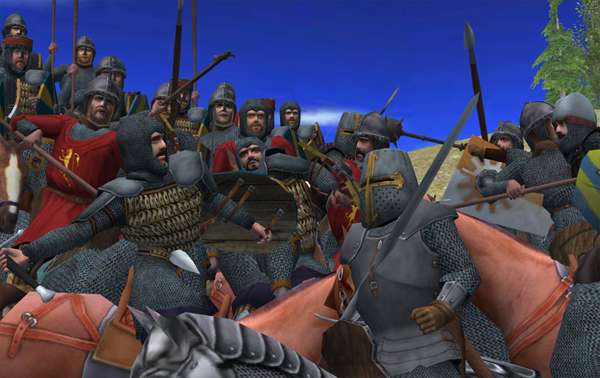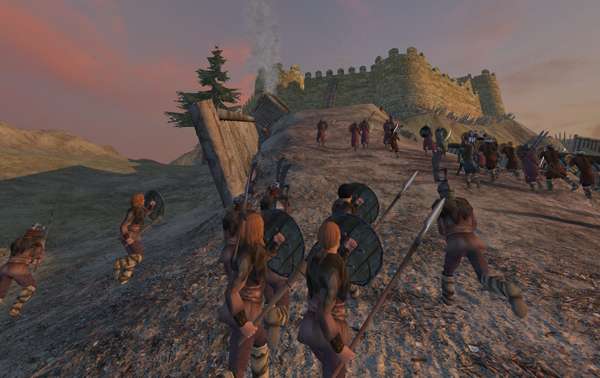Mount & Blade PC Review

So I arrive at this village, right. I can’t remember what it was called. Doesn’t really matter now, for reasons you’ll understand shortly. I look around for a bit, and I find the village elder. I ask him how things are going, and he tells me that the village is a mess because they keep getting raided by bandits. None of the villagers know how to fight, so they just offer up their goods so as not to incur the bandits’ wrath. This will not stand. I’m a fighter, after all. I can do something about this. I tell the village elder that I can train his men to fight. The village elder is overjoyed, and says that if I can train six of his men, they should be safe from the bandits. As the training sessions begin, I remember that I only put one skill point into ‘Teaching’, and things go predictably badly. At the end of each session, I have a short battle with the pupils who I feel have taken my lessons on board – but I’m so rubbish at teaching them that only one pupil from the first group is worth testing. Nevertheless, I only needed to train six of them, so I carried on – another five groups later, I’m done. I look forward to moving on to my next quest, a warm feeling in my belly from a job well done, and a village saved. But as I leave, I hear shouting in the distance. The bandits are here. The villagers pick up their weapons, and I prepare to join them in the fight… until I see that they are vastly outnumbered by the dozens of bandits who charge inexorably through the town, slaughtering as they go. I watch helplessly, and slowly begin to back away from the village, fearing for my own life. In order to punish the villagers for having the nerve to defend themselves, the bandits raze the town, destroying all the buildings and killing most, if not all, of the residents.
In any other game, this would be considered a failure. Not just any old failure, but a full-on GAME OVER scenario. But here, it’s just part of my story. Because this isn’t really like most games you’ve played – this is Mount & Blade.

If you want to break things down in the usual way, M&B is an independently-developed medieval RPG (note: medieval, not ‘fantasy’ – there’s no spell-flinging here, son), played from a third-person perspective, where you can pretty much do whatever you want. Spend some time with it, and you could be forgiven for thinking ‘yeah, I get it – it’s Oblivion with worse graphics’. But only if you’re a fat idiot with a remarkable talent for missing the point. Describing M&B as ‘realistic’ seems a bit far-fetched, but there’s something really refreshing and believable about it. Your character could end up being the greatest warrior in the land, with maxed-out skills and the best equipment there is… but if fifty stick-wielding peasants fall on you, you’re in trouble. If you want to succeed, you need to lead a group of soldiers, which later develops into your very own army. And what you do with that army is totally up to you. Travel around helping or sacking towns and villages, attack trade caravans, or ask the local king to let you become a mercenary captain in his army. Hell, if you wanted to, you could have a decent amount of fun just running trade routes between the towns and cities, fending off groups of bandits as you go.

As you’re probably guessing by now, M&B has more in common with Elite or Sid Meier’s Pirates! than with the likes of the Elder Scrolls series. Chiefly, it’s a game about (fairly simplistic) resource management, travelling, and taking part in some ridiculously awesome battles. Combat seems simplistic at first, but ends up being really satisfying once you get your head around it. It’s less about levelling up your character and getting better equipment, and more about judging your position and speed relative to the enemy, and effective use of blocking and the various melee attacks available. Which isn’t to suggest the game features any fancy special moves, or combos – it’s simply a case of moving the mouse to attack or block in various directions. Sounds a bit shit, I know – but it still makes for some really fun one-on-one battles, and those of you who find it overly-simplistic will be thankful when you find yourselves in a battle against an army ten times the size of your own. That said, you’ll find that you spend most of your time in the larger battles circling the enemy on your horse, sword in hand, occasionally pulling in to take someone’s head off – but this is still far more satisfying than it has any right to be.
The really interesting thing about M&B, though, is the lack of any absolute punishment for failure – in other words, you can’t die. Something of a talking point now that the release of Fable 2 has brought it to more people’s attention, the notion of disallowing player death has been well-implemented in M&B throughout its life as a public beta, and remains so in the finished game. That’s not to say that you won’t ever be punished, of course – if you lose a battle against a group of raiders, for example, they’ll take you prisoner and drag you around for a while, until you’re able to escape from them. So you can continue playing, but you’ve lost all your stuff. That said, such is the game’s commitment to internal consistency, that if you can gather a few men together to take on and defeat the group that captured you, you can then free the rest of your army who were also captured alongside you.

Gamers are so conditioned to repeat sections of a game over and over again if they fail them, but M&B encourages you to accept your failures, and live with them. You can play the game with the typical save system if you want (save whenever, load whenever), but the suggested option is one whereby you can only save when you quit the game. Initially, it’s really difficult to accept – we’re so used to simply loading a previous save if things don’t go quite as planned, because we like the record to show this uninterrupted stream of success. But, as we all know, life is anything but. And it’s through this save mechanic, and the absence of player death, that M&B allows its players to come up with their own narrative that ends up being far more convincing than the rubbish we’re spoon-fed in 98% of the games out there.
For those of you still waiting for me to make some hilarious derogatory comment about the graphics, forget M&B. It’s not for you. Everyone else, if you’re not already convinced, get yourselves over to the TaleWorlds website and download the M&B trial. It might not be to everyone’s tastes, but it makes a whole bunch of interesting and bold design decisions, and I guarantee you’ve not played anything quite like it. For those reasons alone, it gets a glowing recommendation.
